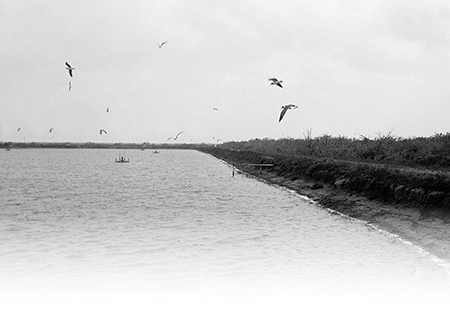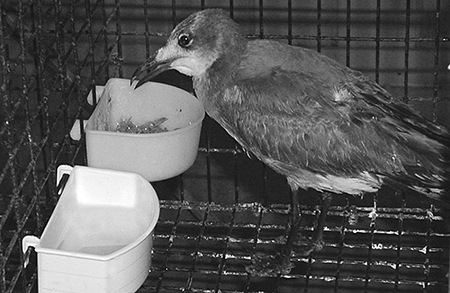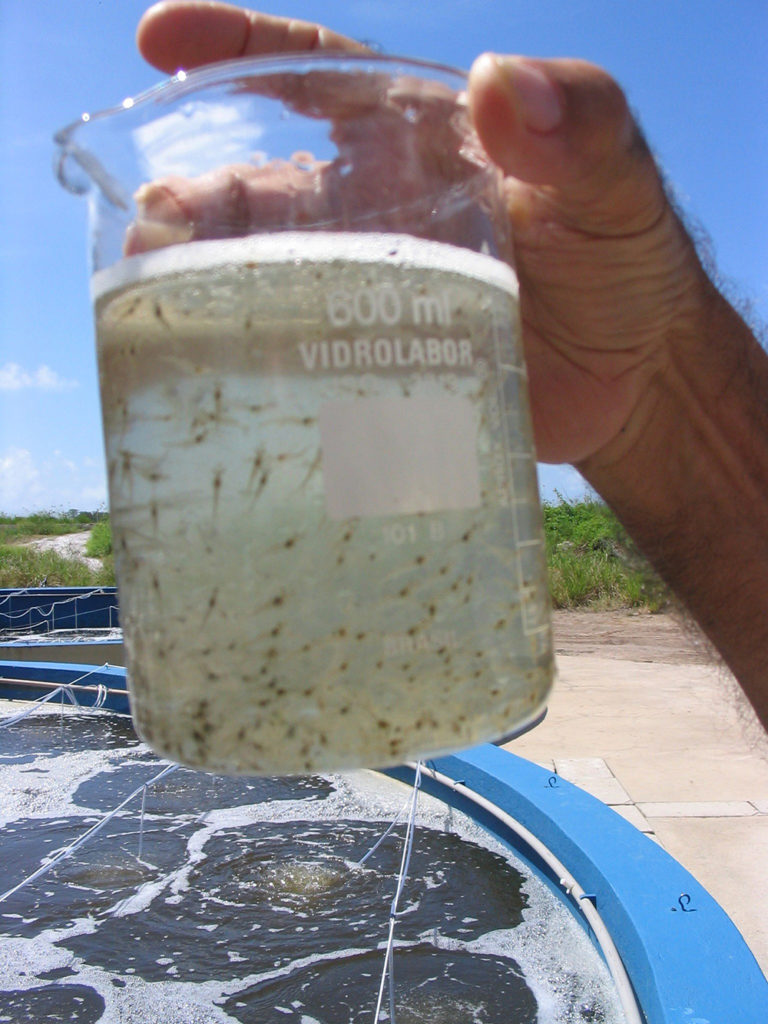Studies have illustrated viral transmission in fish hatcheries

Farmed shrimp are susceptible to viral, bacterial, fungal, and protozoan diseases, with bacterial and viral pathogens the most important. Various viral disease epidemics at shrimp farms resulted in the loss of billions of dollars during 1994-1999. Because such epidemics threaten both the economic viability and long-term sustainability of shrimp farming throughout the world, it is of paramount importance to control and prevent their spread.
Viral transmission
The question of “How did this virus get here?” often comes up after a previously uninfected farm with a successful biosecurity and screening history tests positive for a virus. Viral transmission is, in part, dependent on the amount and duration of shedding, suitable vectors, and environmental survival and stability of the virus.
Viral shedding is accomplished by discharge into respiratory aerosols in vertebrates, feces and body fluids such as hemolymph in shrimp. Because shrimp are cannibalistic scavenger feeders, ingestion of infected shrimp carcasses is a major route of viral transmission. Other routes include inoculation, water-borne transmission, and the presence of vectors.
Sea birds transmit disease
As early as 1925, researchers associated gulls with human disease, noting that gulls forage at dumps, then roost at nearby reservoirs, bringing parasites and contaminants to the water supply. Current observations of sea gulls and other sea birds – terns, cormorants, egrets, herons, and ducks – feeding on dead and dying shrimp during viral outbreaks are now common. As infected shrimp succumb to viral diseases, they typically rise to the surfaces and edges of ponds, where scavenging birds take advantage of an easy meal.
Gulls and other sea birds move between feeding sites, where they consume diseased farmed shrimp and fish in open tanks or cages, and may defecate in the surrounding waters, thus contaminating unaffected areas. Sea birds like herring gulls and black-headed gulls are often seen scavenging on shrimp trawler discards and can also transmit viruses from wild shrimp to nearby shrimp farms.
Reports of bird feces serving as a source of viral transmission in aquatic environments are relatively rare. However, several studies have illustrated viral transmission in fish hatcheries.
Additional studies showed that wild birds, including herons and mallards, excrete Infectious Pancreatic Necrosis Virus in their feces at titres similar to those found in afflicted hatchery fish. Current data illustrates a reduced viral prevalence at fish hatcheries that employ electric fence barriers and netting as bird-deterrence devices.
In addition to serving as mechanical vectors of fish and shrimp viruses, sea birds have been identified as vectors of bacteria such as Yersinia rukeri, the causative agent of enteric redmouth disease, and Myxosoma cerebralis, the causative agent of salmonid whirling disease.
Transmission study

The goal of a study funded by the U.S. Marine Shrimp Farming Consortium as part of a master’s thesis by the first author at the University of Arizona Aquaculture Pathology Lab in Tucson, Arizona, USA, was to identify the role of sea birds as transmission vectors for major shrimp viruses.
Researchers devised a two-part study to test the hypothesis that shrimp-eating birds may carry viable and infectious viral particles in their feces from diseased ponds to nearby unaffected ponds. The first part consisted of feeding shrimp tissues infected with one of several viruses – White Spot Syndrome Virus (WSSV), Taura Syndrome Virus (TSV), Yellow Head Virus (YHV), or Infectious Hypodermal and Hematopoietic Necrosis Virus (IHHNV) – to sea gulls and collecting their feces for standard diagnostic polymerase chain reaction per reverse transcriptase – polymerase chain reaction (PCR/RT-PCR) detection.
Following PCR/RT-PCR detection of the viral nucleic acids in the feces, four separate bioassay challenges were set up as the second part of the study. Specific pathogen-free Litopenaeus vannamei were challenged by injection with homogenized sea gull feces collected in the first part of the study to determine if any of the shrimp viruses remained infectious in gull feces. Histological examination, molecular methods, and in situ DNA hybridization were used to identify viral infection in the challenged shrimp.
Results
Standard PCR testing detected WSSV and IHHNV DNA in the sea gull feces, and RT-PCR detected TSV RNA. YHV RNA was not detectable by RT-PCR in the feces. Preliminary bio-assay results indicated that both IHHNV and TSV can remain infectious following passage through the sea gull gut, but that WSSV and YHV appear to be noninfectious.
DNA is typically more stable than RNA, which may explain why the DNA viruses were detectable, whereas only one RNA virus was detected by RT-PCR. The presence or absence of a lipid-containing envelope may also shed light on the detection and bioassay results.
Lipids are easily degraded by low pH, which is a natural function of the avian stomach as part of the digestive process. Thus, enveloped viruses such as YHV and WSSV may be more difficult to detect in feces, and may pose less of a threat as infectious agents if their protective lipid envelopes are destroyed during the digestive process.
Bird deterrence
Because it is well known that birds pose a predation problem, many bird-deterrence devices are already available to aquaculturists concerned about biosecurity. Many fish-eating birds can not be killed without federal and state permits, but permits are not necessary to scare birds them. Deterrence devices include noisemakers, distress calls, area lights, strobe lights, barricade lights, revolving lights, scarecrows, water level manipulation, and physical barriers such as wires and netting.
In addition to deterrence devices, aquaculturists and fish or shrimp processors should take precautions when disposing of dead infected fish and shrimp to make sure the carcasses are not readily available to scavenging sea birds. In areas where certain shrimp viruses are endemic and viral outbreaks are common, enclosed shrimp culture facilities may be a necessary design feature.
Conclusion
In this study, gulls were shown to be mechanical vectors of shrimp viruses. Gulls that consume shrimp infected with IHHNV and TSV shed infectious viral particles in their feces which can pose a risk to nearby ponds or other bodies of water if the gulls defecate in them soon after feeding. Although WSSV was detectable in the gull feces, the virus was not infectious when bioassayed using susceptible SPF shrimp. YHV was the only virus studied that was not detectable in gull feces.
The construction of future shrimp farm sites may include such design features as establishing a minimum distance between farms based on bird migratory patterns in order to decrease the probability of infection by birds that move from farm to farm.
(Editor’s Note: This article was originally published in the August 2003 print edition of the Global Aquaculture Advocate.)
Now that you've reached the end of the article ...
… please consider supporting GSA’s mission to advance responsible seafood practices through education, advocacy and third-party assurances. The Advocate aims to document the evolution of responsible seafood practices and share the expansive knowledge of our vast network of contributors.
By becoming a Global Seafood Alliance member, you’re ensuring that all of the pre-competitive work we do through member benefits, resources and events can continue. Individual membership costs just $50 a year.
Not a GSA member? Join us.
Authors
-
Kristie A. Vanpatten
University of Arizona
Department of Veterinary Science and Microbiology
Building 90, Room 201
P.O. Box 210090
Tucson, Arizona 85721 USA[117,100,101,46,97,110,111,122,105,114,97,46,117,64,118,97,107]
-

Donald V. Lightner, Ph.D.
University of Arizona
Department of Veterinary Science and Microbiology
Building 90, Room 201
P.O. Box 210090
Tucson, Arizona 85721 USA
Tagged With
Related Posts

Health & Welfare
A comprehensive look at the Proficiency Test for farmed shrimp
The University of Arizona Aquaculture Pathology Laboratory has carried out the Proficiency Test (PT) since 2005, with 300-plus diagnostic laboratories participating while improving their capabilities in the diagnosis of several shrimp pathogens.

Responsibility
A look at various intensive shrimp farming systems in Asia
The impact of diseases led some Asian shrimp farming countries to develop biofloc and recirculation aquaculture system (RAS) production technologies. Treating incoming water for culture operations and wastewater treatment are biosecurity measures for disease prevention and control.

Health & Welfare
A study of Zoea-2 Syndrome in hatcheries in India, part 1
Indian shrimp hatcheries have experienced larval mortality in the zoea-2 stage, with molt deterioration and resulting in heavy mortality. Authors investigated the problem holistically.

Health & Welfare
A study of Zoea-2 Syndrome in hatcheries in India, part 2
Indian shrimp hatcheries have experienced larval mortality in the zoea-2 stage, with molt deterioration and resulting in heavy mortality. Authors considered biotic and abiotic factors. Part 2 describes results of their study.


